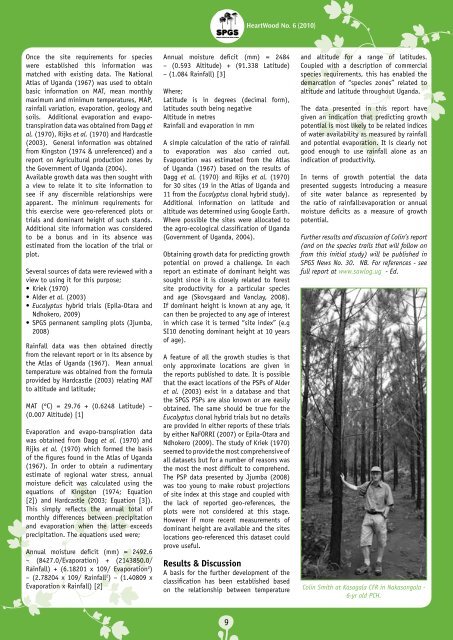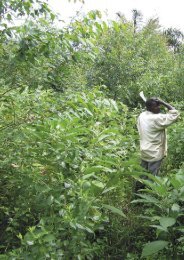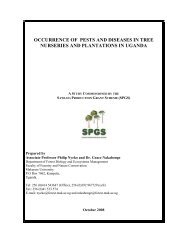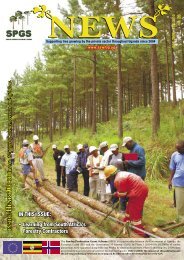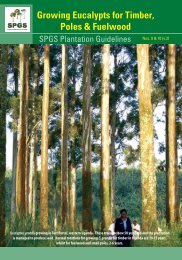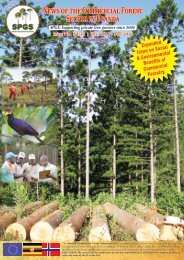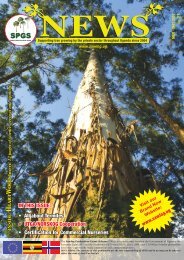Create successful ePaper yourself
Turn your PDF publications into a flip-book with our unique Google optimized e-Paper software.
HeartWood No. 6 (2010)<br />
Once the site requirements for species<br />
were established this information was<br />
matched with existing data. The National<br />
Atlas of Uganda (1967) was used to obtain<br />
basic information on MAT, mean monthly<br />
maximum and minimum temperatures, MAP,<br />
rainfall variation, evaporation, geology and<br />
soils. Additional evaporation and evapotranspiration<br />
data was obtained from Dagg et<br />
al. (1970), Rijks et al. (1970) and Hardcastle<br />
(2003). General information was obtained<br />
from Kingston (1974 & unreferenced) and a<br />
report on Agricultural production zones by<br />
the Government of Uganda (2004).<br />
Available growth data was then sought with<br />
a view to relate it to site information to<br />
see if any discernible relationships were<br />
apparent. The minimum requirements for<br />
this exercise were geo-referenced plots or<br />
trials and dominant height of such stands.<br />
Additional site information was considered<br />
to be a bonus and in its absence was<br />
estimated from the location of the trial or<br />
plot.<br />
Several sources of data were reviewed with a<br />
view to using it for this purpose;<br />
• Kriek (1970)<br />
• Alder et al. (2003)<br />
• Eucalyptus hybrid trials (Epila-Otara and<br />
Ndhokero, 2009)<br />
• <strong>SPGS</strong> permanent sampling plots (Jjumba,<br />
2008)<br />
Rainfall data was then obtained directly<br />
from the relevant report or in its absence by<br />
the Atlas of Uganda (1967). Mean annual<br />
temperature was obtained from the formula<br />
provided by Hardcastle (2003) relating MAT<br />
to altitude and latitude;<br />
MAT (ºC) = 29.76 + (0.6248 Latitude) –<br />
(0.007 Altitude) [1]<br />
Evaporation and evapo-transpiration data<br />
was obtained from Dagg et al. (1970) and<br />
Rijks et al. (1970) which formed the basis<br />
of the figures found in the Atlas of Uganda<br />
(1967). In order to obtain a rudimentary<br />
estimate of regional water stress, annual<br />
moisture deficit was calculated using the<br />
equations of Kingston (1974; Equation<br />
[2]) and Hardcastle (2003; Equation [3]).<br />
This simply reflects the annual total of<br />
monthly differences between precipitation<br />
and evaporation when the latter exceeds<br />
precipitation. The equations used were;<br />
Annual moisture deficit (mm) = 2492.6<br />
– (8427.0/Evaporation) + (2143850.0/<br />
Rainfall) + (6.18201 x 109/ Evaporation 2 )<br />
– (2.78204 x 109/ Rainfall 2 ) – (1.40809 x<br />
Evaporation x Rainfall) [2]<br />
Annual moisture deficit (mm) = 2484<br />
– (0.593 Altitude) + (91.338 Latitude)<br />
– (1.084 Rainfall) [3]<br />
Where;<br />
Latitude is in degrees (decimal form),<br />
latitudes south being negative<br />
Altitude in metres<br />
Rainfall and evaporation in mm<br />
A simple calculation of the ratio of rainfall<br />
to evaporation was also carried out.<br />
Evaporation was estimated from the Atlas<br />
of Uganda (1967) based on the results of<br />
Dagg et al. (1970) and Rijks et al. (1970)<br />
for 30 sites (19 in the Atlas of Uganda and<br />
11 from the Eucalyptus clonal hybrid study).<br />
Additional information on latitude and<br />
altitude was determined using Google Earth.<br />
Where possible the sites were allocated to<br />
the agro-ecological classification of Uganda<br />
(Government of Uganda, 2004).<br />
Obtaining growth data for predicting growth<br />
potential on proved a challenge. In each<br />
report an estimate of dominant height was<br />
sought since it is closely related to forest<br />
site productivity for a particular species<br />
and age (Skovsgaard and Vanclay, 2008).<br />
If dominant height is known at any age, it<br />
can then be projected to any age of interest<br />
in which case it is termed “site index” (e.g<br />
SI10 denoting dominant height at 10 years<br />
of age).<br />
A feature of all the growth studies is that<br />
only approximate locations are given in<br />
the reports published to date. It is possible<br />
that the exact locations of the PSPs of Alder<br />
et al. (2003) exist in a database and that<br />
the <strong>SPGS</strong> PSPs are also known or are easily<br />
obtained. The same should be true for the<br />
Eucalyptus clonal hybrid trials but no details<br />
are provided in either reports of these trials<br />
by either NaFORRI (2007) or Epila-Otara and<br />
Ndhokero (2009). The study of Kriek (1970)<br />
seemed to provide the most comprehensive of<br />
all datasets but for a number of reasons was<br />
the most the most difficult to comprehend.<br />
The PSP data presented by Jjumba (2008)<br />
was too young to make robust projections<br />
of site index at this stage and coupled with<br />
the lack of reported geo-references, the<br />
plots were not considered at this stage.<br />
However if more recent measurements of<br />
dominant height are available and the sites<br />
locations geo-referenced this dataset could<br />
prove useful.<br />
and altitude for a range of latitudes.<br />
Coupled with a description of commercial<br />
species requirements, this has enabled the<br />
demarcation of “species zones” related to<br />
altitude and latitude throughout Uganda.<br />
The data presented in this report have<br />
given an indication that predicting growth<br />
potential is most likely to be related indices<br />
of water availability as measured by rainfall<br />
and potential evaporation. It is clearly not<br />
good enough to use rainfall alone as an<br />
indication of productivity.<br />
In terms of growth potential the data<br />
presented suggests introducing a measure<br />
of site water balance as represented by<br />
the ratio of rainfall:evaporation or annual<br />
moisture deficits as a measure of growth<br />
potential.<br />
Further results and discussion of Colin’s report<br />
(and on the species trails that will follow on<br />
from this initial study) will be published in<br />
<strong>SPGS</strong> News No. 30. NB. For references - see<br />
full report at www.sawlog.ug - Ed.<br />
Results & Discussion<br />
A basis for the further development of the<br />
classification has been established based<br />
on the relationship between temperature Colin Smith at Kasagala CFR in Nakasongola -<br />
6-yr old PCH.<br />
9


